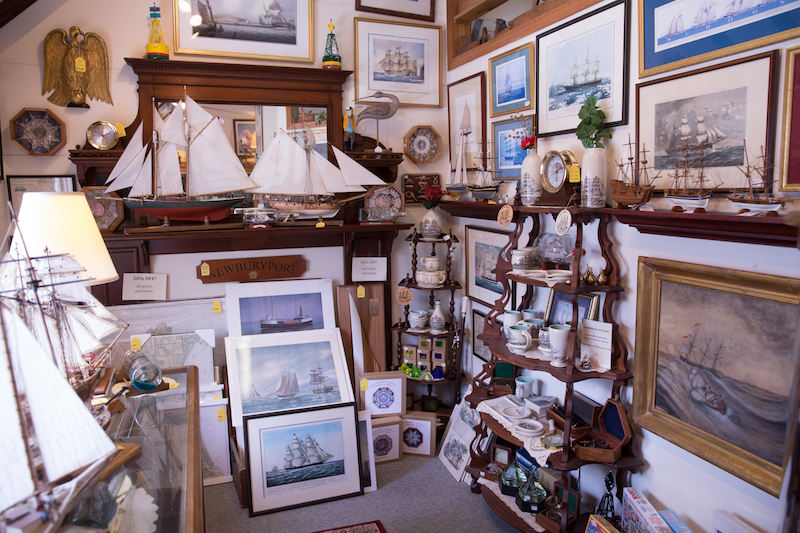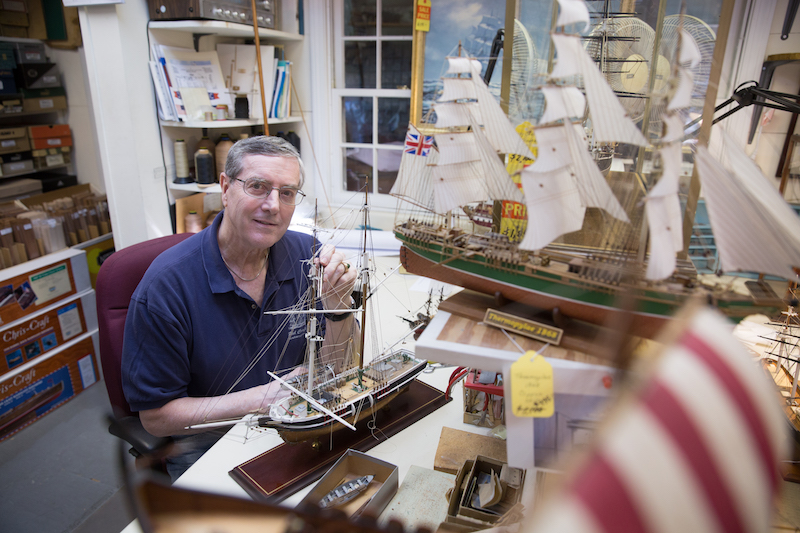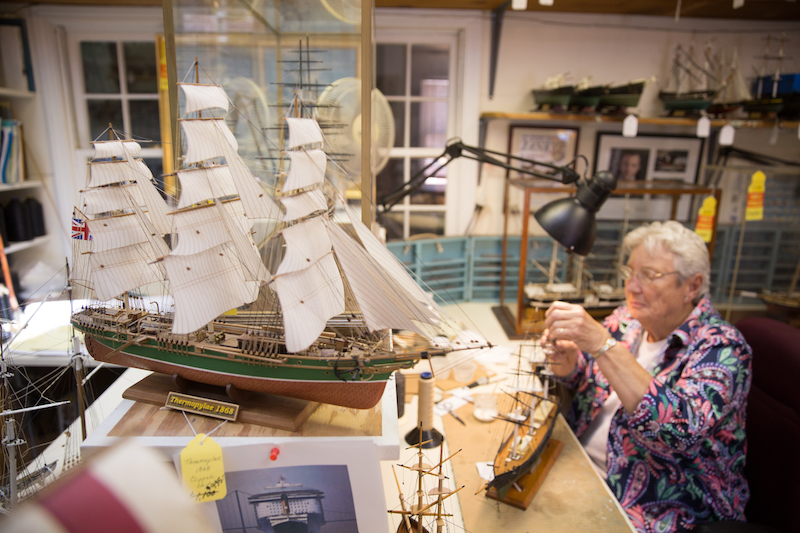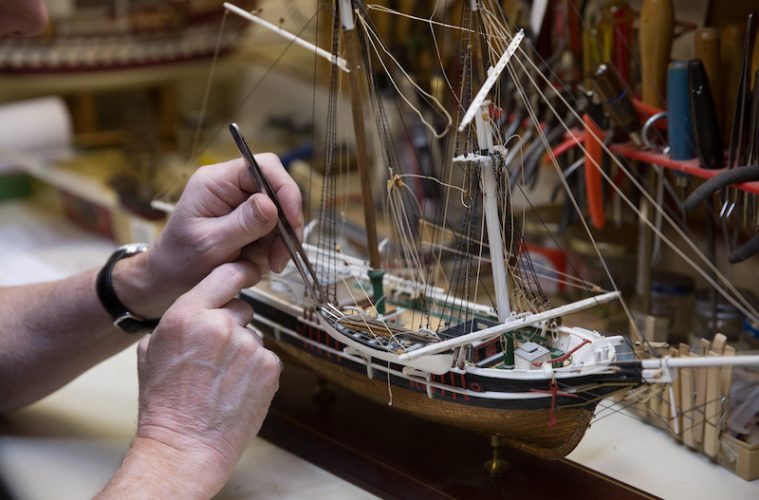In 1982, John Rogers’s brother gave him a gift: an exact replica of the Cutty Sark, the famously fast 19th-century clipper ship that dominated the tea trade. Don Rogers spent 18 months building his brother’s masterpiece, laying each plank by hand and fine-tuning the rigging across the masts. But John’s time with the ship was short-lived.
“After I got it home from California, someone bumped into it and it broke into pieces,” says Rogers, who lives in Plymouth. He packed the broken ship into a box, where it remained for the next 30 years. Then, in 2014, Rogers wandered into Piel Craftsmen, a tiny nautical shop in Newburyport. Glass cases along the walls displayed elaborate model ships evoking three centuries of maritime history. It had been three years since his brother’s passing, and Rogers was ready to repair the broken Cutty Sark.
“They did a beautiful job,” he says. “There are times now when I sit in the den and marvel at the amount of time Don spent making this beautiful work for a younger brother. It seems so much more meaningful now that he’s gone.”
The history books say that Newburyport built its last ship in 1883, marking the end of the city’s once-bustling industry. But that’s not exactly true. Since it opened in the late 1940s, Piel Craftsmen has built some 40,000 ships—everything from armed British merchant boats to New England whalers. And while they might not be high-seas-worthy, they are the work of master builders.
“I’ve been interested in ship modeling and maritime history since I was 17 years old, when I started working for Piel Craftsmen,” says Bill Partridge, the shop’s 71-year-old owner. During college, Partridge apprenticed under the store’s late founder, Ed Piel, who turned to ship modeling as a child after polio limited his mobility. What began as a hobby turned into a thriving business run out of Piel’s Newburyport garage. According to shop records, Piel Craftsmen has built and repaired wooden ships for collectors on every continent except Antarctica.

Piel ran the shop for almost 50 years, until his health declined in 1995. At the time, Partridge was nearing the end of a long career with the former New England Telephone. When he learned the shop would close, he retired early and bought Piel Craftsmen, moving it to its current location at 3½ Center Street.
“Ed was very happy that the business was going to continue and pass to someone he taught,” says Partridge. “But like many of us, we get to that age and we want to continue to do what we love, and he wasn’t able to do that.”
Today, Piel Craftsmen carries on its founder’s work with 14 handmade wooden replicas of famous vessels. Three are models of ships built in Newburyport, including the Massachusetts, the first U.S. revenue cutter. Launched in 1791, the boat patrolled the coast looking for smugglers and was the predecessor to today’s U.S. Coast Guard.
Each Piel Craftsmen ship begins with a solid hull carved of seasoned basswood. The wood is painted to match the original ship’s true colors, and intricate details are added, including deck hatches, cannons, lifeboats, ladders, masts, and sails.
The rigging poses the greatest challenge, and for that Partridge relies on his only employee, 78-year-old Nancy Lewis. The Newburyport native has been with Piel Craftsmen since 1972, and she knows her boats.

“My favorite is the [East Boston clipper ship] Flying Cloud,” says Lewis. “The rigging tension has to be just right—not too tight, not too loose.” Although Piel Craftsmen consigns and restores museum-quality ships—boats with hollow hulls and hand-sawn planks—the shop’s models feature solid hulls. This brings the price down so that novice collectors can afford a piece of authentic maritime art.
That approach and 70 years of word-of-mouth marketing have kept Partridge and Lewis busy. Customers often wait weeks for an authentic Piel Craftsmen ship, and repairs can take just as long. The shop also sells antique nautical tools, historic maps, whalebone carvings, and more than 150 wooden ship kits.
However, Piel Craftsmen’s delicate creations have not always been considered art. During the 19th century, ship modeling was more than a hobby; it was a vital part of the shipbuilding industry. “Back in the day, a model maker was essential for proving out a design before they ever built a ship,” says Peter Tybinkowski, a docent at Newburyport’s Custom House Maritime Museum. “If you ever go to a museum or older home in New England and they have a half-hull over the fireplace, those were the salesman samples of the day. You went to a builder saying, ‘I want you to build a clipper ship of this many tons and with this many sails,’ and he would go to a model maker and have him design a model hull.”
In Newburyport, says Tybinkowski, that process played out in earnest from 1840 to 1860, the height of the city’s shipbuilding boom. In addition to ship modelers, nearly every resident played a role in the industry, from transporting lumber down the Merrimack River to stitching sails and supplying provisions to outgoing ships.

The city quickly developed a reputation for building some of the finest ships on the Atlantic seaboard, including the Dreadnought, a 1,400-ton three-masted clipper ship that reached Liverpool, England, in 10 days, and the Mary L. Cushing, the last square-rigged ship to be built in Massachusetts.
Newburyport’s fortunes turned during the 1880s, as ships transitioned to steam and metal hulls replaced wooden ones. The shipyards began to close, and by the end of the century, the city’s shipbuilding industry was part of maritime lore.
For Partridge and his customers, that proud history and Ed Piel’s legacy live on in Piel Craftsmen’s miniature boats. The shop owner has no illusions about millennials abandoning their smartphones for model building, but that’s OK. Business is good, and Partridge’s tiny shipyard has orders to fill.
“I’m doing what I’m passionate about,” he says, “and not many of us get to do this.”
Piel Craftsmen
3 1/2 Center Street, Newburyport
978-462-2589

